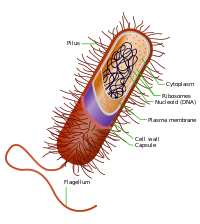
Photo from wikipedia
In common with many bacterial pathogens, Streptococcus pneumoniae has a polysaccharide capsule, which facilitates immune evasion and determines virulence. Recent data has shown that the closely related Streptococcus mitis also… Click to show full abstract
In common with many bacterial pathogens, Streptococcus pneumoniae has a polysaccharide capsule, which facilitates immune evasion and determines virulence. Recent data has shown that the closely related Streptococcus mitis also express polysaccharide capsules including those with an identical chemical structure to S. pneumoniae capsular serotypes. We utilised atomic force microscopy (AFM) techniques to investigate the biophysical properties of S. mitis and S. pneumoniae strains expressing the same capsular serotypes that might relate to differences in virulence potential. When comparing S. mitis and S. pneumoniae strains with identical capsule serotypes, S. mitis strains were susceptible to neutrophil killing and electron microscopy and AFM demonstrated significant morphological differences. Force-volume mapping using AFM showed distinct force-curve profiles for the centre and edge areas of encapsulated streptococcal strains. This "edge effect" was not observed in unencapsulated bacteria, and therefore was a direct representation of the mechanical properties of the bacterial capsule. When two strains of S. mitis and S. pneumoniae expressed an identical capsular serotype, they presented similar biomechanical characteristics. This infers a potential relationship between capsule biochemistry and nanomechanics, independent of bacterial strain. Overall, this study demonstrates that it is possible to investigate reproducibly the mechanistic, structural and mechanical properties of both the capsule and the body of individual living bacterial cells and relate the data to virulence phenotypes. We have demonstrated that using nanomechanics to investigate individual bacterial cells we can now begin to identify the surface properties bacterial pathogens require to avoid host mediated immunity.
Journal Title: ACS nano
Year Published: 2019
Link to full text (if available)
Share on Social Media: Sign Up to like & get
recommendations!